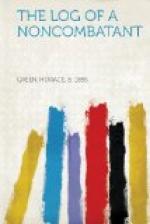When the body of this woman was found, let us say, by French peasants returning to their ruined homes, think how the horrible fact would be seized, without whatsoever there was of justification! How the British and French papers would describe that mutilated form! Think of the effect of a two-column word-picture of the wanton sack and ruin of the town, the shooting of its helpless citizens, and the description of that mangled body sacrified to the Huns! Think how the fact would be clutched by fear-crazed inhabitants, would be bandied from mouth to mouth, distorted and dressed up to suit a partisan press, and “twisted by knaves to make a trap for fools”!
One of the first atrocity accounts which I heard in Belgium, as well as one of the most persistent, had to do with scores of children whose wrists had been cut by the Kaiser’s troops. Hundreds of them were reported to be in Belgium and Dutch hospitals or in the care of relief committees. The gossip was so prevalent and in some instances so specific that I had high hopes of tracking down and seeing, with my own eyes, an instance. In each case which I heard abroad, my informant’s husband or brother or best friend had seen the children; but somehow or other it was never arranged that I could see one of them myself. This type of cruelty was so widely talked about that in plenty of cases the German soldiers believed that some of their men had committed these crimes. One of them told me that he understood that near Tirlemont the wrists of several young children had been cut. He said that thirty or forty children and peasants had fired on and killed German troops marching through a neighboring village. A squad was sent to round up the offenders, all of whom were found armed. Instead of killing the snipers, whose age was between ten and seventeen, the surgeons were ordered to slice the tendons of the wrist so that the noncombatants should be prevented from holding a gun or using a knife.
Soon after my ship, the Lapland, docked in America, I heard a case of whose verity, owing to the source from which it came, I had no doubt. The refugee in question, according to my informant, was an English nurse, and lay with both wrists cut off at a well-known New York hospital on Madison Avenue. She had been in Brussels at the time of the German entry, and, being willing to work for the sake of humanity wheresoever there were sick to care for, she had nursed wounded German officers. Eventually, with a handful of English nurses still remaining in Brussels, she had been deported to Holland, because it was feared that German secrets were leaking out in letters sent by these English nurses. This latter part coincided so precisely with the facts which during my stay in Brussels I had found to be true, that I had no doubt of the whole business. On recovery the nurse was to exhibit herself and lecture for Red Cross funds. I was told this in strict confidence and I was to




